

by Bruce Cornet, Ph.D.
Table of Contents
On 9-10 August 1996 Tom Sinisi and Bruce Cornet witnessed several take-offs and landings at the AOP hotspot. On that particular night a gate to a farm field on the low ridge overlooking the hotspot was open. Cornet decided to take a chance by driving up into that field, where he had a spectacular view of the forests and farm fields that make up the center of the hotspot. But on this particular night Sinisi and Cornet witnessed two take-offs and two landings of Manta Ray-shaped craft.
|
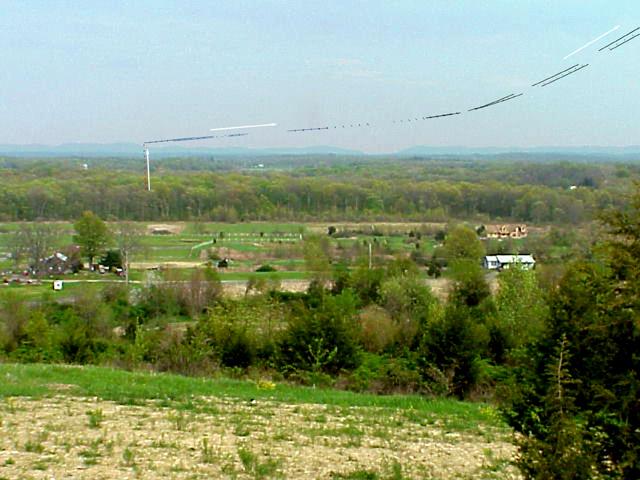
Manta Ray lift off (images below from 9 August 1996) superimposed on daytime shot taken from Thompson Ridge.
11:12 pm event on 9 August 1996.
Coming in for a silent "landing": Craft traveled low over tops of trees at a calculated speed of only 46 mph, stopped in mid air, then dropped out of sight.
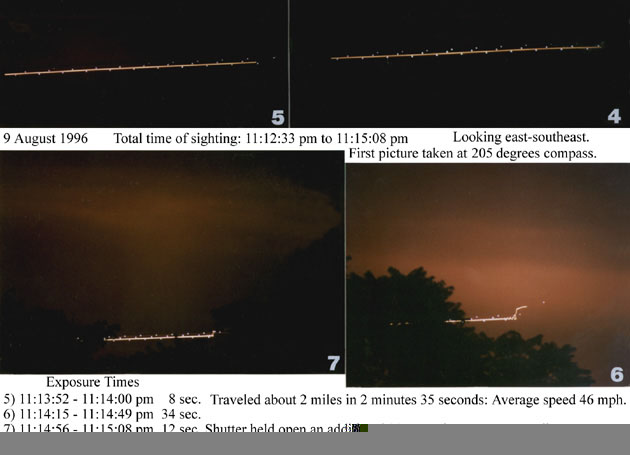
Anomalous Light Movement
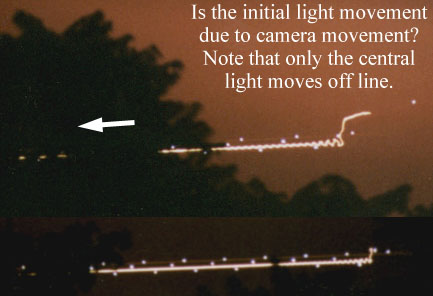
If you examine the two images above closely, accounting for the positions of the central and outboard strobes and their firing pattern, you will discover that the central strobe fires either in sync with the outboard strobes, or in sequence with them from right to left. Therefore, if either the camera bounced or the craft physically moved up and down, the outboard lights should show movement also - especially the straight right light trace which connects the right strobe. But only the central brighter white light moves up and down, while all the other lights remain on an even course. Explain this!
For Comparison
Below is an image of an AOP coming in for a "landing" in the same area on 5 October 1993. Proof that it stopped in mid air can be seen in the strobe lights, which become closer and closer together until they are superimposed when it was hovering just above the trees. The film was highly sensitive Infra Red film, which will become over-exposed easily by heat sources. In the time it took Cornet to close the shutter to his camera and open it again (the film was advanced by a motor drive), this AOP dropped down out of sight behind a row of trees and turned out its lights (either that or it disappeared into the ground). No conventional aircraft or helicopter designed by humans can do that without crashing.
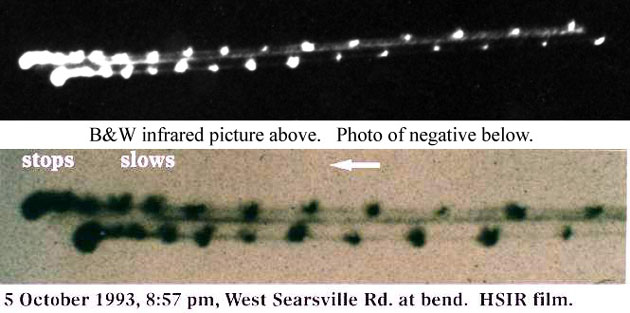
The 11:42 pm event on 9 August 1996.
Craft silently rose up from forest, moved south, then turned and flew over us making a very loud noise.
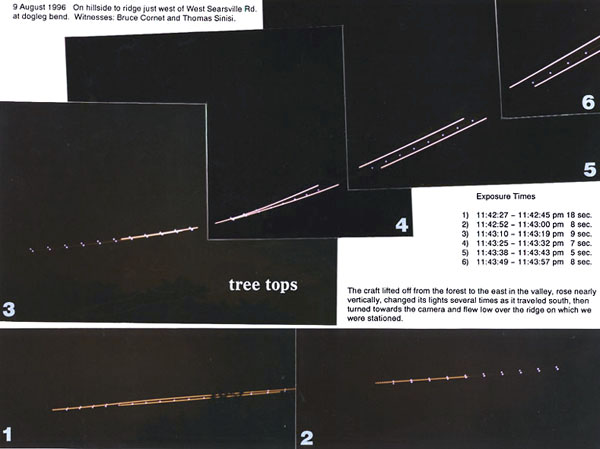
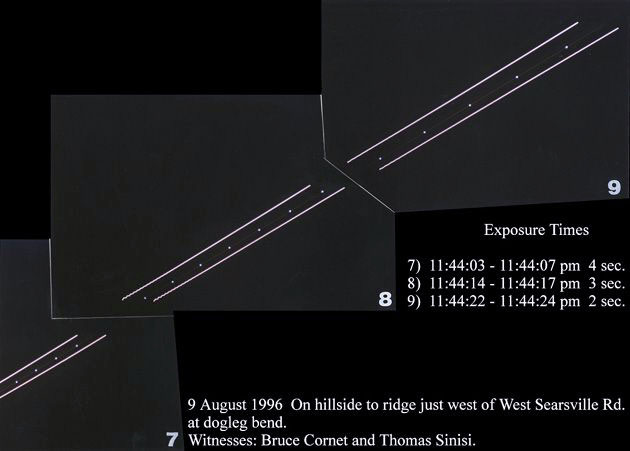
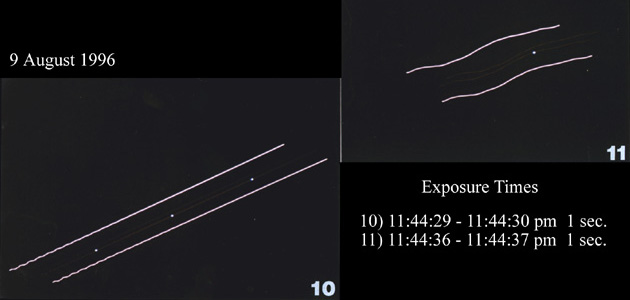
Traveling from east to west, the Manta Ray flew in an arch over us, above the ridge, before descending into adjacent valley.
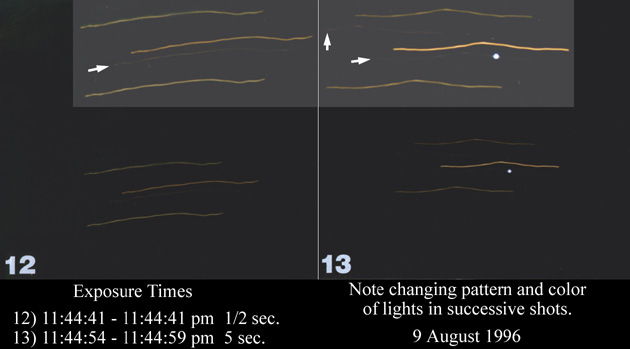
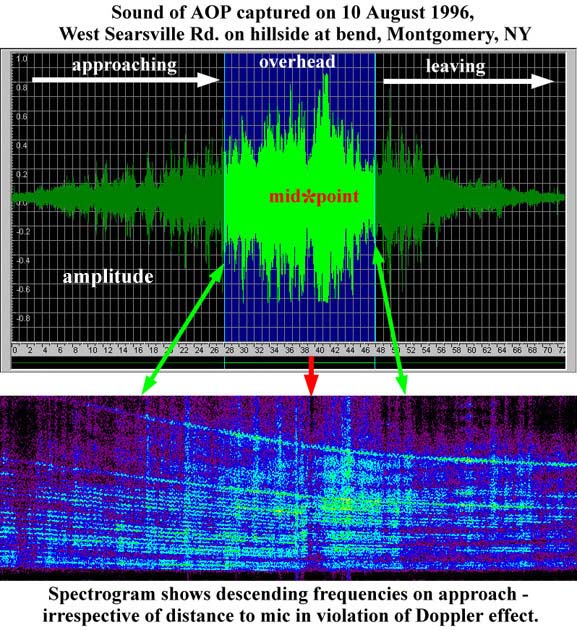
The weird sound that played when this page opened can be downloaded as a wav file. Time of recording is noted in the table above.
To play 8-09-6mb.wav (228K), click on AOP Sound 1.
The original full quality .wav file for AOP sound 1 is 3.2 megs in size. It has been re-encoded to a .ra file of manageable internet size. You will need RealPlayer in order to play it.
To play 8-10-6mc.ra (140K), click on AOP Sound 2.
On 22 January 1997, just after sunset on a rainy evening (5:44 pm EST), the sound heard in August 1996 was recorded again from the same ridge overlooking the Wallkill River valley (at Muddy Kill Lane). The sound was so loud that it caused dogs in the area to begin barking and howling (they can be heard at the end of the recording). Listen to the .ra file below, and then study the amplitude and frequency graphs below. Following the sound a pair of orange-red lights rose rapidly from the valley into the clouds. However, the lights originated somewhere in the valley far from the nearest airport. The nature of the lights and their variations in brightness and color implies that they are not the lights of a conventional aircraft. It is possible that they might belong to the AOP which made the sound. But for that to be the case, the sound had to have been projected more than a mile ahead of the source.
The second time it was recorded in stereo, but because of its size, the full-length version cannot be offered here. The original .wav file was resampled to make it smaller (1.9 megs). It is offered below. It also was re-encoded to a .ra file of manageable internet size. You will need RealPlayer in order to hear it.
To play 1-22-7m3.ra (115K), click on AOP Sound 3.
Download a full stereo version of the 22 January 1997 recording (1.9 megs).Full stereo version 1-22-7m4.wav
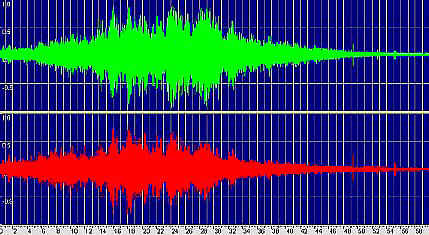
Amplitude (volume) graph and a frequency spectrogram of the same sound are shown below (volume graph on top). The image was compressed laterally in order to exaggerate the apparent frequency shift and to make it more obvious.
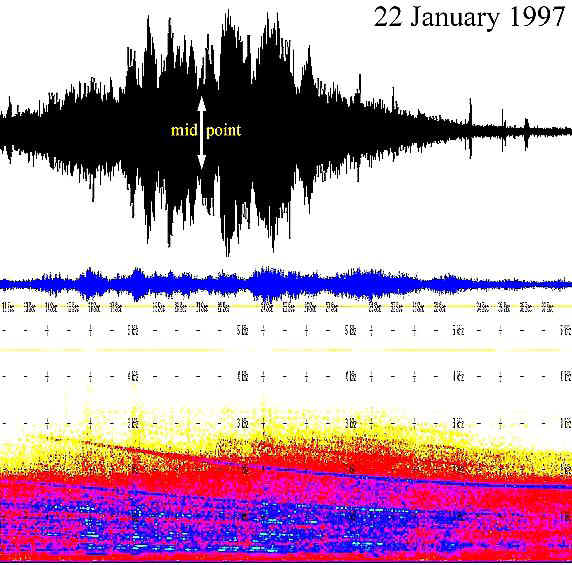
Note how the sound (graph above) is composed of many individual frequencies, like that of the 9-10 August 1996 sounds. Note also how all the frequencies decrease in pitch as the sound volume increases. This is contrary to what physics tells us should happen. The frequencies should not decrease, but level out or rise as the source of the sound approached the microphone. This is due to the Doppler effect, which appears to be violated in this and previous examples.
Individual frames from the video Cornet recorded are presented below. Note how the left light flashes brightly once, and how the right light brightens and then dims. Its color is unusual for that of a conventional aircraft. It is amazing that these lights were recorded at all, given that there was a low cloud ceiling, it was drizzling, and there was a lot of mist in the air. The pair of lights illustrated below rose quickly (21 seconds) and disappeared into the clouds. The lights appeared just above the trees in the valley far from the nearest airport. Perspective is not a factor during this observation, because Cornet was situated above the valley on a ridge. The sound was recorded first before any lights could be seen. Only as the sound abated to the west of Cornet did the pair of yellowish red and white lights begin to rise. If this AOP was responsible for the sound, it had to have projected the sound at least a mile ahead of it. It is also possible that the AOP which produced the anomalous sound did not have any lights turned on, and the AOP which was recorded on video was a second craft taking off after the first one.
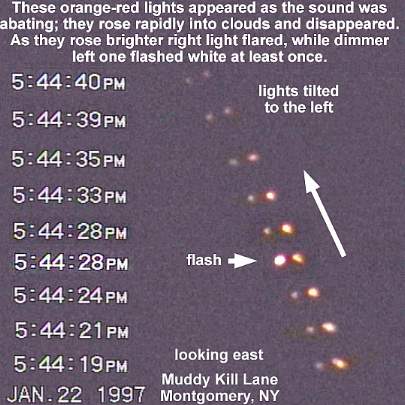
The sound of a conventional jetliner is very different from the above sounds. The conventional sound was recorded when airtraffic flew low over Cornet's residence in May 1997. The sound of a Boeing 747 is graphed below in similar form (by volume and frequency) to the sounds of the AOPs above. Sound progression from left to right.
To play bng747-2.ra (36K), click on Boeing 747 Sound.
The differences are very apparent:
1) The jet sound is not composed of many individual and distinct frequencies.
2) The jet sound became the loudest as the aircraft flew past the microphone, whereas the AOP sounds reached almost full volume well before reaching the microphone.
3) A typical Doppler pattern for the jet of gradually rising frequencies before reaching the microphone and gradually falling frequencies after the microphone contrasts strongly with a pattern of steep declining frequencies for the AOP irrespective of microphone position.
4) The rising frequencies for the jet are not as obvious as the falling frequencies due to the fact that the spectral pallet does not become full until the jet reaches the microphone. This is in strong contrast to a rich pallet of frequencies for the AOP well before it reached the mic, indicating that the sound was projected forward and didn't rely completely on a backward projection of sound as occurs for the jet.
Boeing 747: Sound progression from left to right.
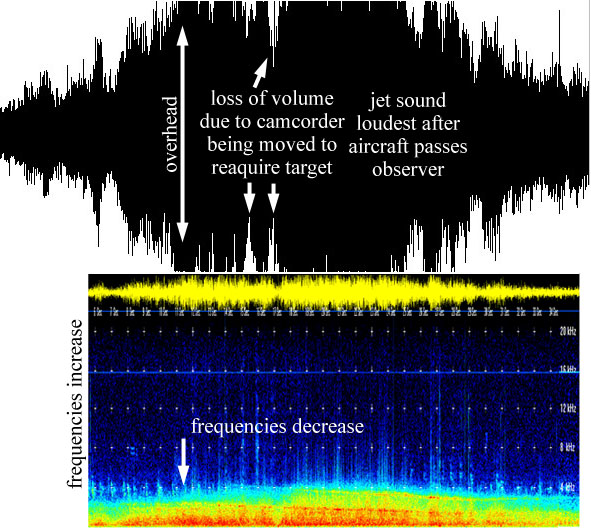
Enlargement of jet sound below.

Frequencies rise only gradually before midpoint (take into consideration the enormous amount of lateral compression of the graph required to show a rise in frequency). Frequencies rise almost imperceptibly until the midpoint, and then they take a very visible plunge as the jet moved away from the mic. This is how the Doppler effect should appear.
Frequency changes for the Boeing 747 do not resemble those of the AOPs documented above. On the contrary, a drop in frequencies begins well before the AOP reached the microphone, and continued to drop long after the AOP moved away from the mic. The amount of frequency drop is significant, which is why the sound produced by the Manta Ray is so strange. It appears to have been intentionally distorted and changed, possibly to test the abilities of witnesses on the ground to distinguish between a sound that is familiar and one that has a mixture of familiar and unfamiliar tones to it.
Based on the data presented here, we cannot conclude whose craft were observed, who flew them, or who made them. And yet, based on the data presented we cannot conclude that these AOP were conventional aircraft. The nature of the sounds the AOP produced indicates highly specialized technology capable of masking the Doppler effect. The synthetic nature of the sounds comes from their apparent manipulation to mask the Doppler effect. An algarithm had to be used to compensate for the Doppler effect, which is evidence that the sound is synthetic. That means that the distance to the mic had to be known for the correct algarithm to be used. Why anyone would produce synthetic sounds such as these is a mystery. Sound is becoming a valuable addition to data collected on Hudson Valley AOP, allowing us a greater degree of certainty that these sightings and recordings were not of misidentified conventional aircraft.
Copyright � 1999 Sirius Onion Works
Last modified:
May 12, 2023